Some of the trade crossings controlled by the Syrian regime and the opposition have become more like border crossings after they were exempted from major military operations according to an “implicit” agreement between the two sides.
Goods, food supplies and basic materials that enter through these crossings are not subject to inspection or any of the customs laws enforced between countries, but they are subject to the laws applied by the Syrian regime and opposition factions at their checkpoints. It is not possible to take anything in or out without paying fees and taxes, which has made barriers a source of wealth for fighters and officers.
Syrians fear that these passages will be transformed into political borders in the future, drawn by the countries that will be influential decision-makers if the Syrian conflict reaches a stage involving division of the country.
Enab Baladi presents the main roads that link the areas controlled by al-Assad’s forces with the cities controlled by opposition factions along the map of territory controlled by the two sides and the movements crossing between them, whether commercial operations or humanitarian cases.
Repeated Closure and Opening of Roads Linking Northern Homs
The areas controlled by Syrian opposition factions in Homs are concentrated in the city of Homs and its northern countryside, which contains dozens of cities, including Talbiseh, al-Rastan and al-Zaafaranah, in addition to al-Hula Valley, which contains the towns of Taldou and Kafr Laha.
The besieged neighborhood of al-Waer will once again be under Syrian regime control after the signing of an agreement in recent days between the regime and the neighborhood’s residents’ committee, which states that the neighborhood’s residents and fighters will be evacuated to the north. After the evacuation, the neighborhood will once again be under the control of the al-Assad regime.
In the early years of the Syrian revolution, the northern towns of Homs were subject to a complete siege, entering a new phase at the beginning of 2016 with the establishment of food and humanitarian passages, with frequent closures and re-opening by the two parties.
The following are two official crossings in the northern countryside of Homs, which form a separation between the opposition and the Syrian regime:
Al-Ghassibiya: “The principal artery”
The crossing was opened on May 28, 2016, on the southern side of al-Dar al-Kabirah from the al-Ghassibiya neighborhood side, after an agreement between “the Supreme Court” and the Syrian regime. The agreement stated that a “humanitarian crossing” would be opened for the northern countryside on the condition that the military factions would open the Homs Crossing, which links the city with the Safita District in Tartus.
During the first phase of the opening of the “commercial and humanitarian crossing”, its use was limited to employees and civilians. It then became a route for the entry of food and relief supplies to besieged towns, later turning into a commercial crossing and “market” for traders from both sides.
In the past few months, the first artery has become a passageway for all kinds of commercial goods. According to information obtained by Enab Baladi, dozens of trucks carrying wood and olive cake (the residue of pressed olives) have entered through this passageway, coming from the towns of the eastern countryside of Homs under regime control.
This operation is carried out by members of the National Defense Force who escort the trucks until they reach the first side of the passage in exchange for payment of fees depending on the cargo and the type of goods.
The crossing was closed several times by the “Supreme Sharia Court” for many reasons, most notably “financial extortion” at the Syrian regime’s checkpoints and “increased economic pressures on residents”. The last closure was at the beginning of March.
“Al-Sama’lil”, a new crossing opened at the beginning of 2017
Al-Sama’lil is the second crossing, after al-Dar al-Kabirah, for towns in the northern countryside of Homs. It was reserved for the entry of food supplies into areas under opposition control in the northern countryside of Homs. It is considered a “humanitarian passageway” for transporting humanitarian and medical cases.
The passage, which is named after the town where it is located (al-Sama’lil), was opened at the beginning of February 2017 to the southeast of al-Hula Valley in order to link the town of al-Hula and the surrounding areas and villages directly with areas under the Syrian regime’s control in the city of Homs.
The crossing and all matters related to entry and exit operations are managed by the Central Sharia Court of al-Hula. After announcing the establishment of the crossing, the court issued the so-called “Traffic Regulations” following an agreement between the Syrian regime and the negotiating committee of al-Hula.
The terms of the agreement, which was adopted when the crossing was first opened, have varied. It allows the exit of students, employees and humanitarian cases but the most important term is the entry of food supplies and permission for the goods to enter after their inspection at the crossing, although the trader cannot exit to Syrian regime areas unless he has personal approval.
No sooner had five days passed than the Supreme Commission had declared its closure due to “the regime’s lack of respect for its commitments to allow the entry of food supplies and vegetables”.
According to Enab Baladi’s sources, some military commanders in al-Hula refused to open the route, considering this to be “a form of surrender to the Syrian regime”.
A source told Enab Baladi that the reason for the closure of the crossing was the fact that “the Syrian regime did not allow the entry of any foodstuffs and only permitted the entry of students and employees in addition to the fact that fuel prices in the area were higher than they used to be before the road was opened”.
Enab Baladi contacted one of those familiar with the crossing’s current operations. He confirmed that the crossing will be re-opened but only partially since “there are no longer the same goods as there were before, it’s now mostly light goods that pass through. All the large cargo stopped after restrictions were imposed by al-Assad forces on the other side”.
A Third Subsidiary Crossing
A third crossing has appeared in the town of Taqsis in the northern part of the besieged cities, which is administratively under the control of the city of Hama.
However, this crossing is not an official one and was used for smuggling into and out of the southern part of the city via buses and trucks.
Three crossings in Daraa supply the regime with vegetables
In Daraa, which is generally considered to be the “breadbasket” of Syria, and of the capital in particular, since it contains vast agricultural areas, farmers in opposition-held areas have been forced to supply regime-held areas with agricultural products and goods because their agricultural produce exceeds the amounts required by consumers. In addition, there is a lack of trade between the “liberated areas” themselves, which would save having to export these products to regime-held areas.
One crossing and two intersecting points (two roads) connect regime-held with those controlled by the opposition in Daraa. They are only a few kilometers apart and have witnessed a trade flow based on the export of agricultural produce in return for basic goods such as fuel, building materials and food supplies.
Fuel reaches Daraa in as-Suwayda
The al-Malihah-Kharaba crossing is considered one of the most important in the province of as-Suwayda. It is located between the town of al-Maliha al Sharqiyyah in Daraa and the town of Kharaba in as-Suwayda, which is under the control of the Syrian regime.
The crossing is controlled by the Free Army on the Daraa side while the other side is under the control of Druze militias, according to information obtained by Enab Baladi. As-Suwayda is controlled by militias affiliated with the Syrian regime in some way, although they are independent in terms of decision-making.
This crossing is considered the real artery for opposition areas, since basic goods, food supplies and building materials enter through it, while vegetables (which Daraa is famous for, most importantly tomatoes) exit through the crossing.
The crossing is also considered the only one through which the Syrian regime allows the entry of fuels (gas and gasoline). If a problem leads to the closure of the crossing, prices become insanely high, especially the price of a gas cylinder. This occurred at the end of 2016, when the price of a cylinder reached 9000 Syrian lira due to poor weather conditions, which made it difficult to cross the soil roads that separate the two sides
Abu Kasser is a purely commercial crossing
In addition to the crossing, there are two main roads – Abu Kasser Road and al-Ghariyah al-Gharbiyah Road – separating the opposition areas in the countryside of Daraa from regime-held areas.
Abu Kasser Road links the city of Da’el in the countryside of Daraa, which is under opposition control, with the international highway (the Damascus-Daraa highway). It is considered the main road between the western countryside of Daraa and Syrian regime areas. This road is under the control of the Free Army on the opposition side.
Abu Kasser was a soil road but was paved after residents in the opposition-held areas began to rely on it heavily for movement and crossings. Vegetables, milk and dairy products, chicken and lamb are exported via this road, while al-Assad’s forces sometimes allow the entry of food and clothing while refusing to allow in fuel.
Traffic in al-Ghariyah al-Gharbiyah
Al-Ghariyah al-Gharbiyah Road is located between the city of al-Ghariyah al-Gharbiyah in northeastern Daraa, which is under opposition control and lies on the international highway, and the city of Khirbet Ghazaleh, which is under the control of al-Assad’s forces.
On the opposition side, the crossing is controlled by Jabhat Fatah al-Sham (Liberation of the Levant Front), which recently joined Hayʼat Tahrir al-Sham (Organization for the Liberation of the Levant). It is the first crossing the group controls in the liberated areas. It sometimes shares control of the crossing with the Free Army but the crossing is known to be under the group’s authority.
The road is considered important for movement rather than for trade as commercial goods and food are very rarely allowed to enter through it. The regime imposes the conditions applied at the Abu Kasser Road, preventing the entry of fuel while allowing food to enter in very small quantities.
There is also a road connecting the city of al-Sanamayn in northern Daraa, which is subject to a settlement with the regime, with the northwestern countryside of Daraa.
The road is used only for road traffic. However, relief agencies, the Red Cross, and the Red Crescent often use the road to bring humanitarian aid into opposition areas.
In addition to these crossings between regime-held and opposition-held areas, there are two main crossings between Daraa and Jordan. The first is the Tell Shihab crossing located in southwestern Daraa and the second is the Nasib crossing in south-eastern Daraa. Both are used for bringing in humanitarian aid as well as evacuating the injured to Jordan following regime air raids.
“Free zones” between Hama and Idlib
The roads connecting between northern Syria and other areas differ in terms of economic movement and trade flows, as well as their strategic significance.
Between the cities of Idlib and Hama, which are controlled by the opposition and al-Assad regime respectively, there are three crossings that are mainly used for economic and commercial flows rather than humanitarian assistance and relief.
Abu Dali: A “mutual incubator“ for the opposition and the regime
The village of Abu Dali located in the northeastern countryside of Hama is one of the most important commercial zones for the various dominant forces in the area. This area is controlled by pro-regime clans led by a member of the People’s Assembly, Sheikh Ahmed Darwish. It is often described as a “free zone” filled with goods, from which the various forces on the ground benefit.
The road between Hama, Abu Dali and the “liberated areas” is a lifeline for both traders and smugglers. It operates based on coordination and mutual agreements among various parties in order to facilitate movement. There are no checkpoints or signs that indicate the presence of monitoring or surveillance points operated by the armed groups that are located not far from the road.
The road is used for a variety of purpose, the most prominent being trade between the regions under regime control and “liberated areas”. Trade consists of the entry of food supplies from opposition-held areas and the entry of fuel from regime-held areas. Along the route, these convoys cannot be obstructed by anyone. According to Enab Baladi’s sources, the process is a trade-off that requires the road to operate normally so that each side can benefit from the shortage of merchandise and basic goods on the other side.
The area has become a passageway for the entry of Turkish goods, which are smuggled into regime-held areas. Any trader can bring his merchandise into the village of Abu Ali then transfer it to the regime-held territory without being inspected at checkpoints. The passage of goods is secured by sheikh Ahmed Darwish’s men who use vehicles to escort the goods and prevent them from being inspected at checkpoints by paying bribes.
In addition to the smuggling of merchandise and fuel, there is another active sort of trade that is prospering amidst the armed conflict on the ground in Syria. For a sum of over three thousand dollars, sheikh Ahmed Darwish’s men smuggle Syrians out of areas controlled by the al-Assad regime to liberated areas in the north of Syria.
Link between Halfaya and Maharda
In the city of Halfaya in the north-west of Hama, which has been under opposition control since August 2016, a crossing was opened two months ago at the edge of the regime-held town of Maharda. The crossing is controlled by several military factions, the most prominent of which is the newly formed Hay’at Tahrir al-Sham.
The crossing is considered a route for civilians rather than a commercial crossing. The locals of Halfaya rely on it for bringing in the goods they need from regime-held areas rather than relying on opposition-held areas in the north, since the road linking the latter to Halfaya is a military road.
The crossing point is extensively used by locals to transport vegetables and the agricultural produce they cultivate, and import basic goods and food supplies from regime areas, making the crossing even more vital for the town’s inhabitants.
Qalaat al-Madhiq: A southern crossing point for the liberated north
Qalaat al-Madhiq is considered a gateway for the Ghab Plain and an agricultural and commercial reserve upon which other villages of rural Hama depend. Qalaat al-Madhiq is also a major articulation of the Shahashbo Mountain, which is regarded as an extension of Mount Zawiya in the northwest of the city of Hama.
This town is seen by the surrounding towns and the freed northern part of Syria as a southern crossing point equivalent to the Bab al-Hawa crossing connecting to Turkey. The crossing is a connecting point for trade and travel, which was imposed by the war due to the challenges of the diversity of the area’s population.
The crossing is controlled by Syrian opposing factions including Hay’at Tahrir al-Sham, except for the historical fortress located on top of a large hill in the southern part of the region. This fortress, which overlooks the plain, is the only remaining point still controlled by the regime, which it uses for surveillance and monitoring operations.
In the course of the regime’s deportation of residents in the last few months of 2016, Qalaat al-Madhiq was transformed into a crossing for gathering deportees before sending them to the city of Idlib and its countryside.
The town took on this new role in the process of evacuating the surrounding areas a few months after the Syrian regime announced the opening of the al-Suqaylabiyah al-Qalaa Road in March 2016, after the road had been closed due to clashes in the area.
The United Nations and the Red Cross have also used the road leading to the town as a route for bringing in humanitarian assistance and transporting the injured as well as prisoners from and into the area.
Economist rules out the possibility of transforming internal crossings into border points
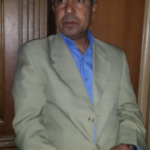
Abdul Karim al-Masri, assistant to the Minister of Finance in the Syrian Interim Government and chairman of the Economists’ Union of Daraa
Abdul Karim al-Masri, assistant to the Minister of Finance in the Syrian Interim Government and chairman of the Economists’ Union of Daraa, ruled out the possibility of transforming the internal crossings into political border points.
He bases his opinion on two factors. The first is that the crossings are intertwined and often located inside towns and villages, which makes it impossible to transform them into borders according to potential plans for dividing up Syrian territory. The second reason is that, according to al-Masri, “the Syrian people will not allow there territory to be divided in any way”.
The chairman of the Economists’ Union told Enab Baladi that the Syrian regime is opening the crossings and roads linking the territories under its control to the liberated areas for its own private interests. The regime uses it to buy agricultural produce such as vegetables, grains and fruit in order to lower the prices in the markets under its control.
Al-Masri added, “The regime prevents the entry of essential materials such as medicines and food supplies such as sugar, rice and flour into the liberated areas, as well as building materials and agricultural materials such as fertilizers, pesticides and seeds, and raw materials for light industry, fuel and gas. Traders are obliged to smuggle these in by giving large bribes at regime crossings and those run by the “People’s Committees”. Meanwhile, non-essential items such as biscuits, chips and sugar are allowed in through the crossings.”
When discussing who benefits most from these crossings, al-Masri said, ”The regime is benefiting the most from these crossings as it covers a very substantial part of the needs of the local population at low prices imposed by the Shabiha (regime thugs). In addition, transport vehicles pay taxes, fees and bribes at the barriers. Employees are allowed to go to work in order to trick the world into believing that institutions are still functioning and have been maintained throughout the six years of the revolution”. Meanwhile, the opposition only benefits from selling farmers’ products as a result of the lack of border crossings with other countries.
Al-Masri pointed out that when farmers sell their products to the regime in Syrian pounds and exchange their foreign currency (which comes from abroad to the liberated areas) through traders in the regime-held areas, the demand for the Syrian pounds increases and the dollar supply rises. This raises of the value of the Syrian pound.
He added, “The effect may only last for a short period but there is an effect nevertheless and it helps to delay the collapse of the Syrian pound”.
if you think the article contain wrong information or you have additional details Send Correction
النسخة العربية من المقال
-
Follow us :











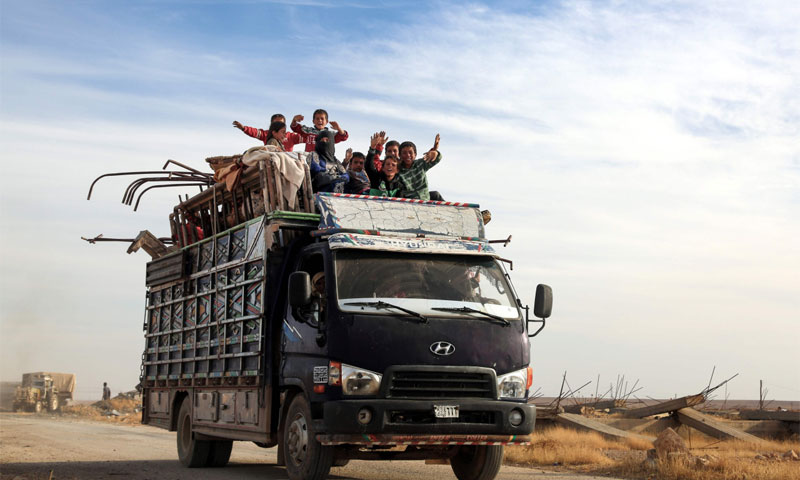






 A
A
A
A
A
A




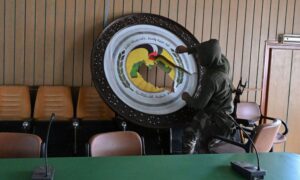
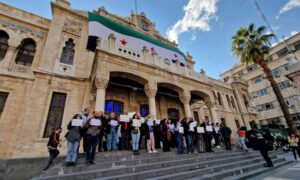
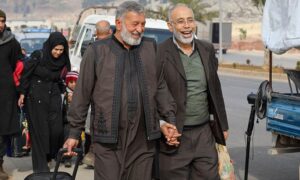

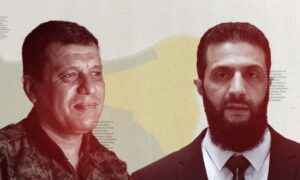
 More In-Depth
More In-Depth